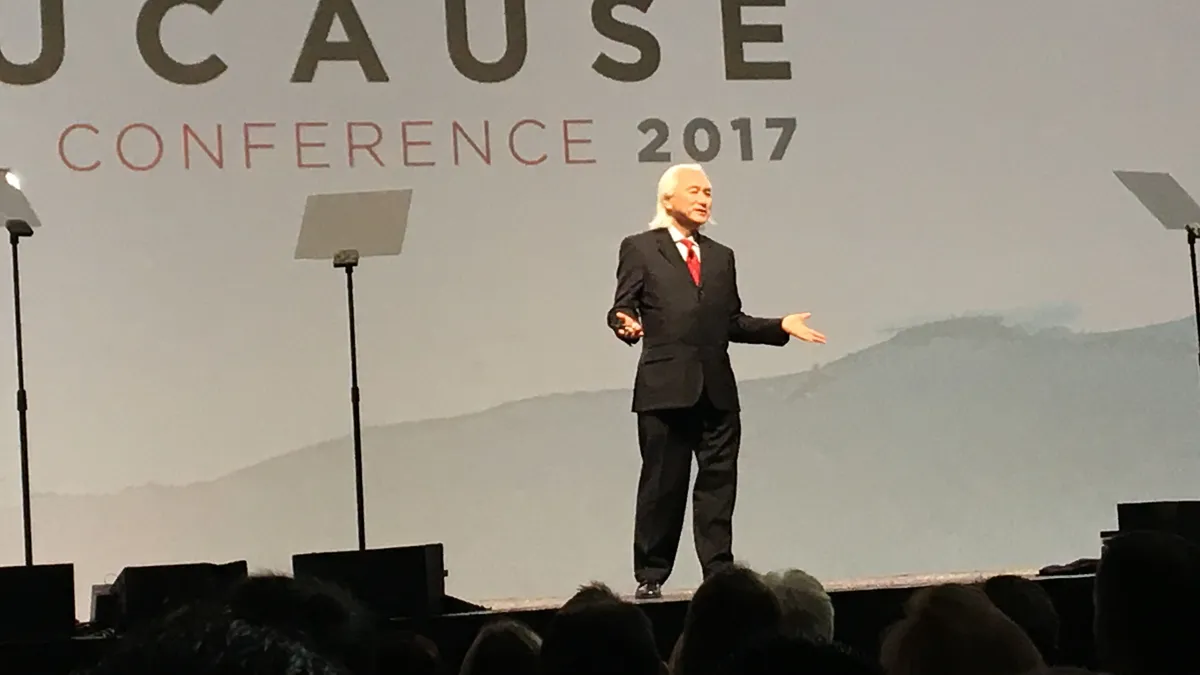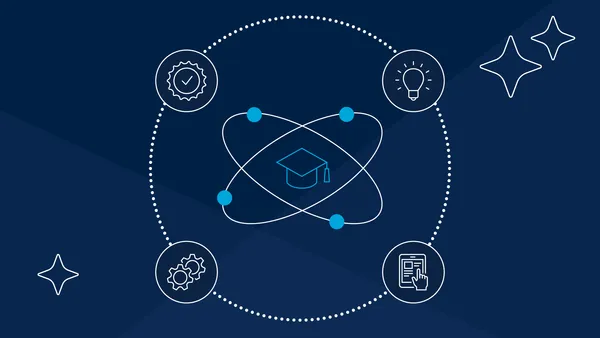The annual Educause conference kicked off Tuesday morning as John O’Brien, the organization’s president and CEO, welcomed over 8,000 attendees to the Pennsylvania Convention Center in downtown Philadelphia. Noting that next year is Educause’s 20th anniversary, O’Brien said he’s overwhelmed by a sense of pride in the community the organization serves, noting its shared sense of purpose, diversity and breadth of ideas.
How big is this years @educause #EDU17 ? Massive! Tremendous! HUGE! More importantly, 8000 quality people! pic.twitter.com/dHAKuKUwRL
— Shel Waggener (@shelwaggener) November 1, 2017
Before opening keynote speaker Michio Kaku’s introduction, O’Brien welcomed West Virginia University Vice Provost and Educause Recognition Committee Chair John Campbell to the stage to announce the 2017 Educause Award recipients. Among them:
- Leadership Award: Susan Metros, Founder and Principal of Metros Consulting, Retired Deputy CIO/Associate Vice Provost for Technology-Enhanced Learning at University of Southern California
- Community Leadership Award: Mark Bruhn, Associate Vice President for Public Safety and Institutional Assurance at Indiana University
- Rising Star Award: Liv Gjestvang, Associate Vice President of Learning Technology in the Office of Distance Education and eLearning at The Ohio State University
Program Committee Chair and Rutgers University CIO Michele Norin then took the stage, introducing Kaku, one of the most widely recognized scientists in the world today.
Kaku opened his presentation joking that awards and accolades can backfire on you, as he was named one of New York Magazine’s smartest people in New York alongside Madonna. He then explained his role as a theoretical physicist, quoting Yogi Berra: “Prediction is awfully hard to do, especially about the future.”
While many of his talking points were similar to those of his ISTE 2016 keynote, his overall message focused on the digitization of society and commerce. Computers will disappear, and the internet will be everywhere and nowhere, like electricity, he said. Doctors, he noted as an example, already have the internet in their glasses, seeing MRI scans, x-rays, patient histories, etc. And the military is further pioneering the tech, miniaturizing the internet to an eye piece. We will live in a combination of virtual and augmented reality, creating imaginary worlds and extracting information from them. Business meetings, conferences, telepresence, tours, education, training and more will be done in virtual reality, and contact lenses will solve sickness issues with VR glasses/goggles.
Internet-enabled contact lenses will translate languages to English and feed you the names and biographical info of people you’re talking to. Of course, Kaku joked, college students will also use them to cheat on exams, but in all seriousness, this means education will change and memorization won’t be emphasized the way it is now.
“The digitization of society is inevitable,” he said. 3D printers are giving us machine parts, clothing, toys, and human organs and tissues. Intelligent plastic paper will give us “smart wallpaper,” through which users will communicate with AI doctors, lawyers, educators and more. But these people won’t be replaced by the AI, as they provide intellectual capital. The middle men, however, won’t be so lucky, going the way of blacksmiths and wagonmakers before them.
In the case of education, “Mentoring cannot be done by a robot. Robots are adding machines. They don’t think at all,” he said.
@michiokaku the destroyer of science is middle school science. Let’s stop teaching kids memorization is science!!! #EDU17
— Jeff Chicki (@jeffchicki) November 1, 2017
Not everyone, however, was sold on Kaku's talk.
So far I feel like I'm hearing a very engaging person read Wired magazine to me #EDU17
— A. Michael Berman (@amichaelberman) November 1, 2017
Again... feeling the keynote this morning is a bit too “in the year 2000” Conan O’Brien and not enough thoughtful conversation #EDU17 pic.twitter.com/9L69oFKxKt
— Austin Dylan Laird (@adlaird) November 1, 2017
This keynote feels like the outcome of an education in science with no humanities. It should be a cautionary tale, not an aspiration. #edu17
— Kyle Johnson (@kyleejohnson) November 1, 2017
The 2017 ECAR Faculty and Student Technology Surveys
In a Tuesday morning session, Educause Director of Research D. Christopher Brooks and Senior Researcher Jeffrey Pomerantz dissected data collected from more than 35,000 students at 110 institutions in 40 states and 11,141 faculty members at 131 institutions in 37 states on technology and its usage in higher education. The student and faculty reports were both designed so the data could be analyzed side-by-side, according to Brooks and Pomerantz.
Notably, students and faculty both heavily prefer a hybrid learning environment at 79% and 71%, respectively. Furthermore, 77% of students reported a hybrid learning environment was the most effective option for them, and took an average of 3.7 courses with online components last year. Faculty taught an average of 3.2 sections.
Students also reported wanting more lecture capture and early-alert systems, while faculty want more video and multimedia production, collaboration tools and LMS. The survey found demand from both for OER, as well as a shared desire for less tablets, social media and e-portfolios.
For more details on Educause’s Technology Research in the Academic Community (ETRAC), check out their page here.
The leaky pipeline to higher education leadership
In addition to the ETRAC surveys, Pomerantz's additional research on holes in the pipeline to higher ed IT leadership was spotlighted among a series of poster sessions in the show's main exhibit hall. The data can be seen in the graphic pictured below.
What are best practices for reimagining your institution's IT organization?
A packed afternoon session saw Davidson College CIO Raechelle Clemmons, University of Richmond CIO Keith McIntosh and Colgate University CIO Steve Fabiani discuss the strategies and goals behind their efforts to rethink IT at their institutions. Among the topics discussed were where they saw the greatest successes with their plans and what they might do differently next time.
Keep an eye out for a full recap in the coming days.
CIOs share views on building out institutional analytics to solve business problems, make decisions
In another session moderated by HelioCampus CEO Darren Catalano, University of Massachusetts Lowell CIO Michael Cipriano, Ithaca College CIO David Weil, University of North Carolina System Interim CIO Steven Hopper, and St. Edward's University Chief Data Officer Justin Sloan detailed how their institutions took the plunge into data analytics.
Over the course of the session, they shared best practices in doing due diligence on defining a strategy to effectively use data to make decisions, solve problems and more. At Ithaca, for example, Weil said analytics were helping a focus on yield, retention and philanthropy since the private institution is highly tuition-dependent. Analytics is helping the school to understand why students are choosing Ithaca and what the school can do to retain them and attract more. For other panelists, proactive approaches to student success were also among issues that were top-of-mind.
Sloan said that at St. Edward's, the selection process for analytics was driven by a vendor experience akin to "Whack-A-Mole," with each solution driven by their one question. St. Edward's was interested in the holistic environment and choosing a tool that didn't feel like trying to tackle 100 problems across 100 platforms.
A data analytics initiative cuts across all departments at an institution, and Cipriano said his school's data analytics approach is now allowing deans to bring the tool in use to meetings and seek the answer they need immediately when a data point comes up. Hopper said that the UNC System set out to overhaul a "1970s approach" to data, now collecting information from all campuses in the system in a single data warehouse and blending them together in a single platform environment for any of those campuses to use.
Weil added that analytics led to stakeholders in more departments being informed about issues being addressed around enrollment, recruitment and retention and that the school's chief analytics officer and president had championed those efforts and made them a success.
Deloitte and Educause issue report on new federal data protection rules
- Deloitte’s Center for Higher Education Excellence and Educause on Tuesday issued a joint report, “Federal funding for Higher Education Institutions at Risk,” detailing how upcoming federal data protection requirements could impact colleges and universities financially.
- The requirements, detailed in National Institute of Standards and Technology’s (NIST) Special Publication 800-171, are meant to protect controlled unclassified information (CUI), and they include an expected Federal Acquisition Regulation (FAR) that will be published by the end of 2017 and incorporated alongside them in federal government contracts.
- Three compliance challenges identified in the report include lack of executive and board level attention, cultural barriers and governance coordination, but suggested steps to compliance include forming a working group with representation from the institution’s main business units, analyzing impact and scope on applicable contracts, and assessing security and where the data is stored.
Annual Ellucian Survey details importance of institutional tech-savviness to students
- Ellucian on Tuesday released results from its annual study, conducted by Wakefield Research among 1,000 college students, in a report titled “Students Are Looking for Personalized Experiences: Do Colleges Deliver?”
- Among the findings: 97% of students reported that tech is as important to their success outside the classroom as it is within, with 87% reporting that institutional tech-savviness was a factor in their decision to apply.
- Additionally, 58% reported that their college or university was the most behind in personalizing their experience compared to other companies or organizations, and they also want to feel more emotionally connected to their institutions.
New vibeffect data explores impact of gap years
- Leading up to Educause, vibeffect announced the results of its third annual College Optimizer Index, digging in to the trend of students taking an intended or unintended “gap” year between high school and college.
- A fifth of U.S. students responding in the study said they took at least a semester off between high school and attending a traditional four-year institution, though only 65% said they intended to do so.
- The remaining 35% suggested outside factors influenced their taking a gap year, with African-American students most likely to take a gap, gap semesters more common than full years, and general optimism that debt can be paid off within a decade.
Cengage partners with Unizin, hundreds of institutions; launches gen-ed OER suite
- Cengage has been busy at this year’s show, promoting a handful of announcements made during the preceding weeks that include an exclusive partnership with Unizin as well as hundreds of partnerships with colleges and universities.
- The Unizin partnership will bring exclusive course design, production services and curriculum analysis to the collaborative’s 25 member institutions, aiming to raise retention and success, while the other announced partnerships with hundreds of institutions nationwide are focused on providing affordable course materials.
- Speaking of affordable course materials, Cengage also recently unveiled OpenNow, a suite of general education course resources with curriculum-aligned open educational resources with pricing starting at $25 per student per course.






















